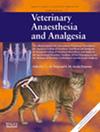Efficacy of a single central injection of lignocaine at the scrotal neck on the behavioural response of lambs to castration
IF 1.4
2区 农林科学
Q2 VETERINARY SCIENCES
引用次数: 0
Abstract
Objective
To compare the behavioural responses of lambs to ring castration with or without local anaesthetic administration by single midline injection at the scrotal neck.
Study design
Blinded, randomized block design pen study.
Animals
A group of 60 male Merino lambs; 6–8 weeks of age; average body weight of 18.5 ± 0.33 (mean ± standard error of the mean) kg at the time of castration.
Methods
Lambs were randomly assigned to three groups of 20: 1) NUMNUTS – lamb placed in a marking cradle and ring castrated with 1.5 mL lignocaine 2%; 2) SHAM – lamb placed in marking cradle and the scrotum manipulated as though an elastrator castration ring were applied; and 3) RING – lamb placed in the marking cradle, ring castration performed using an elastrator. Pain-related behaviours annotated for 1 full minute every 5 minutes post-procedure, from video footage collected for 2 hours post-procedure, according to a defined ethogram.
Results
Lignocaine administration led to significant (p < 0.05) reductions in restless behaviour at 5 and 10 minutes in NUMNUTS lambs compared with RING (mean = 0.2 ± 0.4 versus 1.0 ± 0.4, respectively) post castration. A significant (p = 0.01) reduction in foot stamping and kicking behaviour at 5 minutes post castration (mean = 1.5 ± 0.4, for RING versus 0.4 ± 0.4 for NUMNUTS) and significant (p = 0.001) reduction in the sum of all acute pain-related behaviours at 5 minutes post castration.
Conclusion and clinical relevance
A single midline injection of local anaesthetic at the scrotal neck can alleviate the behavioural responses to ring castration in the immediate post-procedure period. However, the duration of effect was limited, which may be a result of the drug we used. Development of a longer-lasting local anaesthetic formulation is imperative to optimize pain mitigation for ring castration.
阴囊颈部单次中心注射利多卡因对阉割羔羊行为反应的影响。
目的:比较阴囊颈部单次中线注射局部麻醉和非局部麻醉对环去势羔羊的行为反应。研究设计:盲法、随机区组设计钢笔研究。动物:一组60只雄性美利奴羔羊;6-8周龄;去势时平均体重18.5±0.33 kg(均数±标准误差)。方法:将羔羊随机分为3组,每组20只:1)NUMNUTS -羔羊置于标记摇篮中,用1.5 mL 2%的利多卡因环形阉割;2) SHAM -将羔羊置于标记摇篮中,并像使用阉割环一样操作阴囊;和3)环-羔羊放置在标记摇篮,环形阉割进行使用脱毛器。根据定义的心电图,从术后2小时收集的视频片段中,每5分钟对疼痛相关行为进行1分钟的注释。结果:与RING相比,给予利多卡因导致NUMNUTS羔羊在去雄后5和10分钟的躁动行为显著(p < 0.05)减少(平均值分别为0.2±0.4和1.0±0.4)。在阉割后5分钟,跺脚和踢脚行为显著减少(p = 0.01) (RING的平均值为1.5±0.4,NUMNUTS的平均值为0.4±0.4),所有急性疼痛相关行为的总和在阉割后5分钟显著减少(p = 0.001)。结论及临床意义:阴囊颈部单次中线注射局部麻醉可减轻环去势术后即刻的行为反应。然而,效果持续时间有限,这可能是我们使用的药物的结果。一种更持久的局部麻醉制剂的发展是必要的优化疼痛缓解环阉割。
本文章由计算机程序翻译,如有差异,请以英文原文为准。
求助全文
约1分钟内获得全文
求助全文
来源期刊

Veterinary anaesthesia and analgesia
农林科学-兽医学
CiteScore
3.10
自引率
17.60%
发文量
91
审稿时长
97 days
期刊介绍:
Veterinary Anaesthesia and Analgesia is the official journal of the Association of Veterinary Anaesthetists, the American College of Veterinary Anesthesia and Analgesia and the European College of Veterinary Anaesthesia and Analgesia. Its purpose is the publication of original, peer reviewed articles covering all branches of anaesthesia and the relief of pain in animals. Articles concerned with the following subjects related to anaesthesia and analgesia are also welcome:
the basic sciences;
pathophysiology of disease as it relates to anaesthetic management
equipment
intensive care
chemical restraint of animals including laboratory animals, wildlife and exotic animals
welfare issues associated with pain and distress
education in veterinary anaesthesia and analgesia.
Review articles, special articles, and historical notes will also be published, along with editorials, case reports in the form of letters to the editor, and book reviews. There is also an active correspondence section.
 求助内容:
求助内容: 应助结果提醒方式:
应助结果提醒方式:


